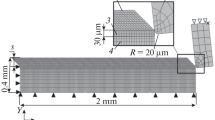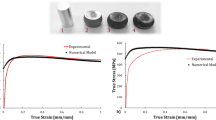Abstract
This study presents a 3D residual stress modelling method in turning of AISI 4140 steel. To carry out this work, we used a recently developed server-based software called MISULAB, which incorporates physically machined surface and 3D thermo-mechanical loadings. Simple longitudinal turning tests and residual stress measurements of the turned surface were conducted, and the effects of the feed rate and tool geometry including a wear zone on the simulation results for the residual stress gradients were considered. Experimental and simulation results on the residual stress gradients induced by longitudinal turning of AISI 4140 steel at two low feed rates (0.05 mm/rev and 0.1 mm/rev) clearly showed the effects of the feed rate on residual stress gradients.












Similar content being viewed by others
References
Matsumoto Y, Hashimoto F, Lahoti G (1999) Surface integrity generated by precision hard turning. CIRP Annals, 48–1, pp 59–62
Elsheikh AH, Shanmugan S, Muthuramalingam T, Thakur AK, Essa FA, Ibrahim AMM, Mosleh AO (2022) A comprehensive review on residual stress in turning. Adv Manuf 10:287–312
Ee KC, Dillon OW Jr, Jawahir IS (2005) Finite element modelingof residual stresses in machining induced by cuttingusinga tool with finite edge radius. Int J Mech Sci 47:1611–1628
Nasr MNA, Ng EG, Elbestawi MA (2007) Modelling the effects of tool-edge radius on residual stresses when orthogonal cutting AISI 316L. Int J Mach Tools Manuf 47:401–411
Magalhaes FC, Ventura CEH, Abrao AM, Denkena B (2020) Experimental and numerical analysis of hard turning with multi-chamfered cutting edges. J Manuf Process 49:126–134
Valiorgue F, Rech J, Hamdi H, Gilles P, Bergheau JM (2012) 3D modeling of residual stresses induced in finish turning of an AISI304L stainless steel. Int J Mach Tools Manuf 53:77–90
Mondelin A, Valiorgue F, Rech J, Coret M 3D hybrid Numerical Model of residual stresses: Numerical—Sensitivity to cutting parameters when turning 15-5PH Stainless Steel. J Manufactruing Mater Process, 5–70;1–16, 2021.
Dumas M, Fabre D, Valiorgue F, Kermouche G, Van Robaeys A, Girinon M, Brosse A, Karaouni H, Rech J (2021) 3D numerical modelling of turning-induced residual stresses – A two-scale approach based on equivalent thermo-mechanical loadings. J Mater Process Technol 297:117274:1–13
Jawahir IS, Brinksmeiern E, M’Saoubi R, Aspinwall DK, Outeiro JC, Meyer D, Umbrello D, Jayal AD (2011) Surface integrity in material removal processes: recent advances. CIRP Ann 60(2):603–626
Ambrosy F, Zanger F, Schulze V (2015) FEM-simulation of machining induced nanocrystalline surface layers in steel surfaces prepared for tribological applications. CIRP Ann 64(1):69–72
González G, Segebade E, Zanger F, Schulze V (2019) FEM-based comparison of models to predict dynamic recrystallization during orthogonal cutting of AISI 4140. Procedia CIRP 82:154–159
Tekkaya B, Meurer M, Dölz M, Könemann M, Münstermann S, Bergs T (2023) Modeling of microstructural workpiece rim zone modifications during hard machining. J Mater Process Technol 311:117815
Meurer M, Tekkaya B, Schraknepper D, Bergs T, Münstermann S (2022) Numerical prediction of machining induced residual stresses when hard cutting AISI 4140. Procedia CIRP 108:583–588
Zielinski T, Vovk A, Riemer O, Karpuschewski B (2022) Influence of local material loads on surface topography while machining steel 42CrMo4 and inconel 718. Procedia CIRP 108:412–417
Rami A, Kallel A, Sghaier S, Youssef S, Hamdi H Residual stresses computation induced by turning of AISI 4140 steel using 3D simulation based on a mixed approach. Int J Adv Manuf Technol, 91:3833–38502017
Cedric C (2011) Vers une modélisation physique de la coupe des aciers spéciaux: intégration du comportement métallurgique et des phénomènes tribologiques et thermiques aux interfaces (in French). PhD thesis, Ecole Centrale de Lyon,
Aridhi A, Perrad T, Valiorgue F, Courbon C, Rech J, Brosse A, Girinon M, Truffart B, Karaouni H (2022) Comparison of the CEL and ALE approaches for the simulation of orthogonal cutting of 15-5PH and 42CrMo4 materials. Proc Institution Mech Eng Part B J Eng Manuf. https://doi.org/10.1177/09544054221136390. November
Capello E (2005) Residual stresses in turning: part I: influence of process parameters. J Mater Process Technol 160(2):221–228
Sharman AR (2006) An analysis of the residual stresses generated in Inconel 718™ when turning. J Mater Process Technol 173(3):359–367
Roy S, Kumar R, Das RK, Sahoo AK (2018) A comprehensive review on machinability aspects in hard turning of AISI 4340 steel. IOP Conference Series: Materials Science and Engineering, 390:012009,
Schulze V (2022) Surface conditioning in cutting and abrasive processes. The International Academy for Production Engineering
Malakizadi A, Bertolini R, Ducobu F, Kilic ZM, Magnanini MC, Shokrani A (2022) Recent advances in modelling and simulation of surface integrity in machining–a review. Procedia CIRP 115:232–240
Melkote S, Liang SY, Ozel T, Jawahir IS, Stephenson DA, Wang B (2022) A review of advances in modeling of conventional machining processes: from merchant to the present. J Manuf Sci Eng 144:110801–110801
Acknowledgements
The authors are grateful to the MISU project for funding this research. Thanks are due to Vincent Lozano and Loïc Polly for their technical support regarding MISULAB. Special thanks to Karlsruhe Institute of Technology and professor, Volker Schulze for the provision of AISI 4140 bars and tool inserts for the CIRP surface conditioning project.
Author information
Authors and Affiliations
Corresponding author
Ethics declarations
Conflict of interest
The authors declare that they have no conflict of interest.
Additional information
Publisher’s Note
Springer Nature remains neutral with regard to jurisdictional claims in published maps and institutional affiliations.
Electronic supplementary material
Below is the link to the electronic supplementary material.
Rights and permissions
Springer Nature or its licensor (e.g. a society or other partner) holds exclusive rights to this article under a publishing agreement with the author(s) or other rightsholder(s); author self-archiving of the accepted manuscript version of this article is solely governed by the terms of such publishing agreement and applicable law.
About this article
Cite this article
Han, S., Valiorgue, F., Cici, M. et al. 3D residual stress modelling in turning of AISI 4140 steel. Prod. Eng. Res. Devel. 18, 219–231 (2024). https://doi.org/10.1007/s11740-023-01241-3
Received:
Accepted:
Published:
Issue Date:
DOI: https://doi.org/10.1007/s11740-023-01241-3




